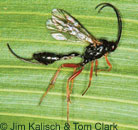Parasitoids
 The most abundant group of parasitoids is the wasps (order Hymenoptera). Parasitic wasps exhibit complete metamorphosis with a free-living adult stage that may be predaceous or feed on pollen and nectar. Parasitoids require a host insect to develop into adults. In the majority of parasitoids, females lay an egg(s) in, on or near the host. The larva hatches and feeds within a host, ultimately killing it, and emerging as an adult parasitoid.
The most abundant group of parasitoids is the wasps (order Hymenoptera). Parasitic wasps exhibit complete metamorphosis with a free-living adult stage that may be predaceous or feed on pollen and nectar. Parasitoids require a host insect to develop into adults. In the majority of parasitoids, females lay an egg(s) in, on or near the host. The larva hatches and feeds within a host, ultimately killing it, and emerging as an adult parasitoid.
Parasitic wasps share two diagnostic features that greatly contribute to their success. Female wasps have an ovipositor that allows them to deposit eggs on or in a host body. Parasitoids also have a narrow “waist,” called the petiole, which allows their abdomens to be highly flexible. This facilitates attack of active or protected hosts. The size of parasitoids is quite variable, and the visibility of these features depends partly on size.
Learn more about parasitoids:
- Aphelinid wasp, Aphelinidae
- Braconid wasp, Braconidae
- Ichneumonid wasp, Ichneumonidae
- Trichogramma wasp, Trichogrammatidae



 Print
Print Email
Email